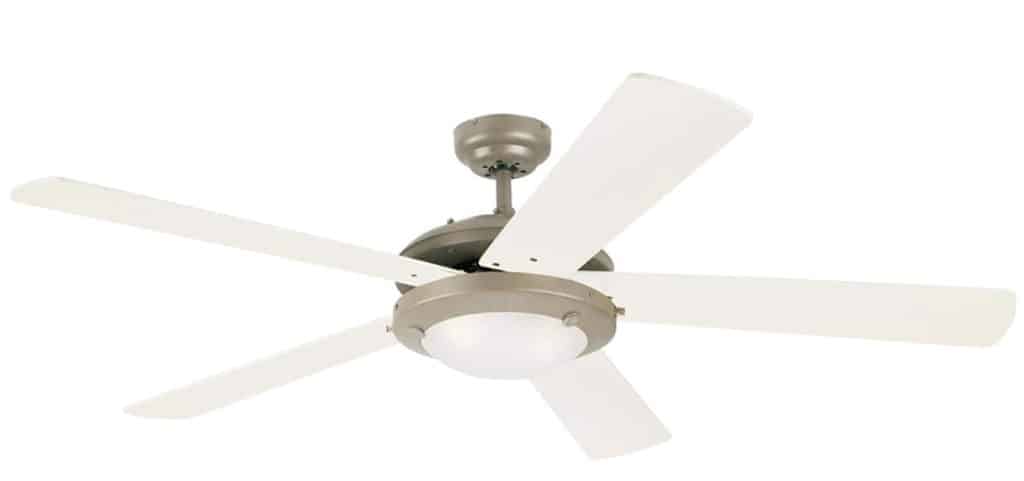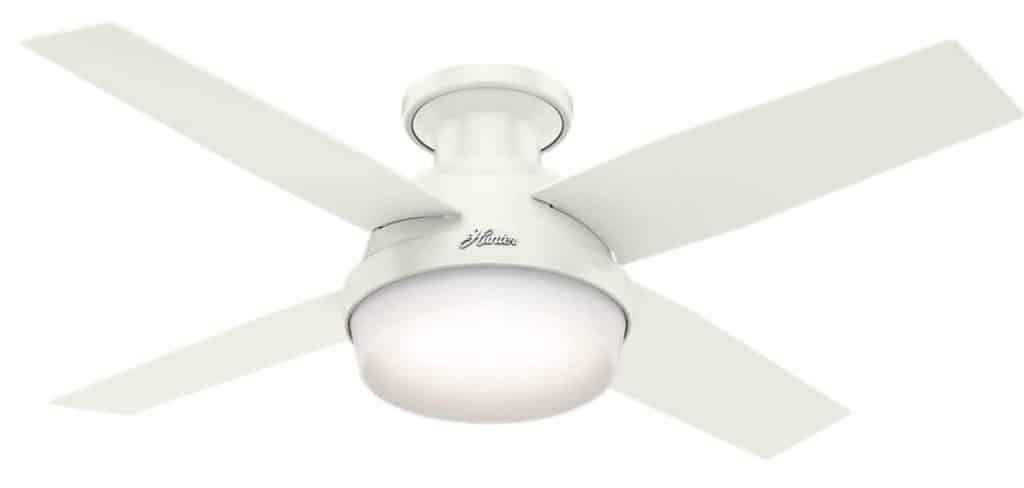Balancing staying cool during summer and lower energy bills is a feat many homeowners want to do but find hard to accomplish. Usually, in the summer, you turn on the air conditioner to keep the temperature down, but a ceiling fan is a much more efficient option.
Why Ceilings Fans Are Great
Growing up I always had a ceiling fan in my room and while I wanted the AC on in the summer, I grew to love the slight breeze and movement in the air a ceiling fan creates. I ended up running the fan almost the entire year, always turning in in the opposite direction in the winter to promote warmer air circulation.
Now that I’m paying the bills, I’m acutely aware that the more time you use the air conditioner the higher your energy bill will be. Unfortunately, many of us have accepted this and made due, but fans can help. And this isn’t the “help” in the way that you’ll save a few dollars a year — air conditioners use a lot of power and with the use of fans you can reduce your summertime power consumption by almost 40%.
How To Choose The Right Fan For You
Here are our tips on what to consider when buying your ceiling fan.
Size of the room
Choose the fan’s diameter based on the size of the room. The bigger the room, the bigger the fan should be!
A 36″ fan is rather small and would be more suitable for a room under 100 square feet (10′ by 10′).
For rooms larger than 100 square feet, you have choices. The size of ceiling fans for such rooms is usually 42″ and up. In the case you have rooms with an area up to 400 square feet (20′ by 20′), you should go for a 50″ or larger fan to look appropriate for the room.
You could even go bigger, with many nicer fans going up to 60″ diameter for larger rooms. Anything larger than this and you will be usually looking at specialty fans.
Of course you could always buy multiple fans for very large rooms, but this can look odd and can be annoying to control. It might work for a great room setup but usually it’s one ceiling fan to one room.
Fan Blade Pitch
The purpose of the ceiling fan is to circulate air within the room. Two factors determine this, the weight of the blades and the pitch of the blades. For the best results, you must ensure that the blades are matched in both weight and size. If the blades are mismatched then the fan will wobble when running.
Heavier blades mean a fan that can spin more slowly and that uses more power. Usually fans have the blades they have, and you can’t pick the material, but some fans will offer options of ABS plastic blades, wood, and/or aluminum so you can choose which suit your performance and, more so, aesthetic requirements.
The pitch of the fan determines the amount of air circulating in the room at a given fan speed. Generally, the pitch is between 12 and 15 degrees. If the fan has a pitch less than 12 degrees, it will not circulate the air properly. This isn’t a huge factor, but it’s something to keep in mind if you want to dig into the details!
Light Or No Light?
Not all ceiling fans have lights built into them. This is especially true of higher-end fans, where the light can take away from the design and aesthetic appeal of these fans.
Basically, the most you pay for a fan, the less likely you’ll get the light included! In most fans above the $400 mark, you’ll have to pay about $100 or so to have an LED light in built into the fan.
Regardless of the price, if you need a ceiling light, make sure your fan has one or can be upgraded to accomodate one!
Distance From The Ceiling
Most fans are placed on some kind of downrod, which is like a pipe that hangs down from the ceiling to the body of the fan. The taller the ceiling, the longer the downrod. The space between the fan and the ceiling (created by the downrod) can improve air circulation and make the fan more efficient.
If your ceiling is 8′ high or less, you don’t need a downrod and it will be unsafe to use one.
Usually downrods are an accessory not part of the fan itself, but it’s still an important part of the purchase. Also, if you are a ceiling that is 8′ or under, you need to buy a flush mount fan!
Here are the downrod lengths you should consider (though make sure to consult your manufacturer as well):
- 8′ or Less: Flush mount fan with no downrod
- 9′: 6″ downrod
- 10′: 12″ downrod
- 11′: 18″ downrod
- 12′: 24″ downrod
- 13″: 36″ downrod
- 14″: 48″ downrod
- 15″: 60″ downrod (anything past 48″ will likely be custom)

The Volume Level Of The Fan
A motor is used to power any ceiling fan. Certain factors determine the amount of sound it makes. This can include the type of motor, the power of the motor, the housing it’s in, the material and weight of the fan blades, and the pitch of those blades.
This is all rather technical, so rather than try to turn into a volume detective, we’d recommend checking out the spec sheets of the fans you are considering and making sure the one you end up buying isn’t abnormally loud.
Warranty
Consider the warranty offered by the manufacturer. Few companies offer a lifetime warranty or in-house servicing any more, but some will offer limited protections that are worth knowing about, like a lifetime warranty on the motor.
Fans have gotten cheaper but they are rarely designed to work for decades any more, so research the warranty and see if it’s worth getting a fan that will last for years and years or if it’ll be more cost effective to replace it over time.

Suitability For Outdoors And Bathrooms
Ceiling fans are always OK to work indoors, but some can also work in wet conditions, which includes bathrooms, and others will also be able to work outside, such as on a screened-in porch. You’ll have to buy a fan that is specifically designed to work in either or both of these conditions.
For outdoors, you must should a fan that is UL-listed for outdoors. They have a covering that protects the motor moisture. It is the same for bathrooms. Choose a fan that UL-listed for damp conditions.
Conclusion
Buying a ceiling fan would help you manage summer better. You can remain chill without drastically increasing your power supply bill. However, you have to buy the fan from a reputable dealer. Choose a company with highly knowledgeable customer service associates.

